- Importance of Proper Care
- 1. Optimal Growth:
- 2. Disease Prevention:
- 3. Nutrient Uptake:
- 4. Increased Yield:
- 5. Pest Control:
- Choosing the Right Variety
- Optimal Growing Conditions
- Providing Adequate Watering
- 1. Watering Frequency
- 2. Watering Techniques
- 3. Watering Amount
- 4. Mulching
- Appropriate Fertilization Techniques
- 1. Soil Testing
- 2. Balanced Fertilizer Selection
- 3. Timing
- 4. Application Rates
- 5. Placement
- 6. Watering After Application
- 7. Organic Options
- 8. Monitoring and Adjusting
- Pest and Disease Management Pepper plants are susceptible to a variety of pests and diseases. Here are some tips to help you manage them and keep your plants healthy: Pest Management 1. Aphids: Apply insecticidal soap or a mixture of water and dish soap to control aphids. You can also introduce beneficial insects like ladybugs, lacewings, and parasitic wasps to help control aphid populations. 2. Spider Mites: Spider mites can be controlled by regularly spraying the leaves with water to wash off the mites. If the infestation is severe, consider applying a miticide or insecticidal soap. 3. Flea Beetles: Use row covers to prevent flea beetles from attacking your pepper plants. If you notice flea beetles, remove them by hand or spray the plants with neem oil or insecticidal soap. 4. Slugs and Snails: Create physical barriers like copper tapes or diatomaceous earth around your plants to prevent slugs and snails from reaching them. You can also handpick them in the evening when they are more active. Disease Management 1. Bacterial Spot: Remove and destroy infected plants to prevent the spread of bacterial spot. Avoid overhead watering and provide good air circulation around the plants to reduce moisture on the leaves. 2. Powdery Mildew: Powdery mildew can be managed by applying sulfur-based fungicides or using neem oil. Make sure to water the plants at the base to keep the leaves dry. 3. Blossom End Rot: Blossom end rot is caused by calcium deficiency in the soil. Ensure a consistent and adequate supply of calcium through proper watering and adding calcium-rich fertilizers or amendments. 4. Phytophthora Root Rot: To manage phytophthora root rot, avoid overwatering and ensure proper drainage. Use disease-resistant pepper varieties and rotate crops to help prevent the disease. By following these pest and disease management practices, you can minimize the impact of pests and diseases on your pepper plants and maximize their yield and health. Pruning and Training Techniques Pruning and training techniques play a crucial role in the growth and productivity of pepper plants. By implementing these techniques, you can ensure proper air circulation, sunlight exposure, and overall health of your pepper bushes. Here are some top tips to help you prune and train your pepper plants effectively: 1. Pinching off Suckers One important technique is to pinch off suckers that grow between the main stem and the leaf branches. Suckers are secondary stems that can drain energy from the main plant, resulting in reduced fruit production. By removing them, you allow the plant to focus its energy on growing and ripening peppers. 2. Removing Diseased or Infected Leaves Regularly inspect your pepper plants for any signs of disease or infection, such as yellowing leaves or spots. If you spot any diseased or infected leaves, promptly remove them to prevent the spread of the problem to other parts of the plant. This pruning technique helps maintain the overall health of the plant. 3. Supporting the Pepper Bushes Pepper plants can become heavy with fruit, causing the branches to droop or even break. To prevent this, use stakes, tomato cages, or trellises to support the pepper bushes. Gently tie the branches to the support structure using soft gardening twine. This training technique ensures that the plants grow upright and the branches don’t snap under the weight of the peppers. 4. Pruning for Air Circulation Adequate air circulation is vital for pepper plants as it helps prevent the development of fungal diseases. Prune the lower leaves and branches that touch the ground as they can become a breeding ground for fungal spores. Additionally, thin out dense foliage by removing some of the leaves and branches from the center of the plant to improve airflow. 5. Training the Main Stem Training the main stem of pepper plants can help promote better growth and higher yields. When the plant is around 12 inches tall, gently pinch off the top leaves to encourage lateral growth. This technique stimulates the plant to produce more branches, leading to a bushier and more productive pepper plant. 6. Pruning Overgrown Plants If your pepper plants become overgrown, prune them back to a manageable size. Remove any excessively long branches and trim the top to stimulate new growth. Pruning overgrown plants helps redirect energy to the remaining branches, resulting in better fruit production and overall plant health. Remember to sterilize your pruning tools with rubbing alcohol or bleach between each cut to prevent the spread of disease. By implementing these pruning and training techniques, you can maximize the yield and strengthen the overall growth of your pepper bushes. Harvesting and Storing Peppers Harvesting peppers at the right time is essential to ensure optimal flavor and texture. Follow these tips for a successful pepper harvest: Wait until the peppers are fully mature before harvesting. They should have reached their full size and color. Use a sharp knife or pair of shears to cut the pepper from the plant. This helps prevent damage to the plant and ensures a clean cut. Avoid pulling the peppers off the plant as this can cause damage to the stem and plant. When harvesting, handle the peppers gently to avoid bruising or cutting the skin. Harvest peppers in the morning when they are cool and firm. This is when their flavor is at its peak. Check the peppers for any signs of disease or pest damage before harvesting. Discard any damaged peppers to avoid spreading the problem. After harvesting, it’s important to store the peppers properly to maintain their freshness and quality. Here are some tips for storing peppers: Store peppers in a cool, dry place, such as the refrigerator. Peppers can stay fresh for up to two weeks when stored properly. Do not wash the peppers before storing, as this can promote rotting. Instead, wipe off any dirt or debris with a dry cloth. If you have an abundance of peppers, consider preserving them by freezing or canning. This can extend their shelf life for months. When freezing peppers, remove the stem, seeds, and inner membranes before placing them in a freezer-safe bag or container. For canning, follow a trusted recipe and process the jars according to the instructions to ensure safety. By following these tips, you can enjoy a bountiful harvest of delicious peppers and make them last throughout the year. “Question-Answer” What are some tips for growing peppers? Some tips for growing peppers include choosing the right location with plenty of sunlight, using rich and well-drained soil, providing regular and consistent watering, and applying organic fertilizer. How can I boost the yield of my pepper plants? To boost the yield of your pepper plants, you can start by pinching off the first buds that appear on the plants. This will encourage more branches and more fruit to grow. Additionally, providing adequate water and nutrients, such as organic fertilizer, can also help increase yield. What type of soil is best for growing peppers? The best type of soil for growing peppers is rich and well-drained soil. Peppers prefer a pH level between 6.0 and 6.8. Adding organic matter, such as compost, to the soil can help improve its fertility and drainage. How often should I water my pepper plants? It is important to provide regular and consistent watering to your pepper plants. They usually require about 1-2 inches of water per week, depending on the weather conditions. It’s best to water deeply and less frequently rather than shallowly and frequently. Can you give some advice on protecting pepper plants from pests? To protect pepper plants from pests, you can start by regularly inspecting the plants and removing any pests you find by hand. Applying natural pest repellents, such as neem oil or garlic spray, can also help deter pests. Additionally, planting companion plants like marigolds or basil can attract beneficial insects that prey on pests. What are the benefits of using organic fertilizer for pepper plants? Using organic fertilizer for pepper plants offers several benefits. It provides essential nutrients to the plants, improves the soil structure, promotes microbial activity, and enhances long-term soil fertility. Organic fertilizers also tend to be more environmentally friendly and sustainable compared to synthetic fertilizers. “Video” Does Topping Peppers Increase Yields & Growth?
- Pepper plants are susceptible to a variety of pests and diseases. Here are some tips to help you manage them and keep your plants healthy: Pest Management 1. Aphids: Apply insecticidal soap or a mixture of water and dish soap to control aphids. You can also introduce beneficial insects like ladybugs, lacewings, and parasitic wasps to help control aphid populations. 2. Spider Mites: Spider mites can be controlled by regularly spraying the leaves with water to wash off the mites. If the infestation is severe, consider applying a miticide or insecticidal soap. 3. Flea Beetles: Use row covers to prevent flea beetles from attacking your pepper plants. If you notice flea beetles, remove them by hand or spray the plants with neem oil or insecticidal soap. 4. Slugs and Snails: Create physical barriers like copper tapes or diatomaceous earth around your plants to prevent slugs and snails from reaching them. You can also handpick them in the evening when they are more active. Disease Management 1. Bacterial Spot: Remove and destroy infected plants to prevent the spread of bacterial spot. Avoid overhead watering and provide good air circulation around the plants to reduce moisture on the leaves. 2. Powdery Mildew: Powdery mildew can be managed by applying sulfur-based fungicides or using neem oil. Make sure to water the plants at the base to keep the leaves dry. 3. Blossom End Rot: Blossom end rot is caused by calcium deficiency in the soil. Ensure a consistent and adequate supply of calcium through proper watering and adding calcium-rich fertilizers or amendments. 4. Phytophthora Root Rot: To manage phytophthora root rot, avoid overwatering and ensure proper drainage. Use disease-resistant pepper varieties and rotate crops to help prevent the disease. By following these pest and disease management practices, you can minimize the impact of pests and diseases on your pepper plants and maximize their yield and health. Pruning and Training Techniques Pruning and training techniques play a crucial role in the growth and productivity of pepper plants. By implementing these techniques, you can ensure proper air circulation, sunlight exposure, and overall health of your pepper bushes. Here are some top tips to help you prune and train your pepper plants effectively: 1. Pinching off Suckers One important technique is to pinch off suckers that grow between the main stem and the leaf branches. Suckers are secondary stems that can drain energy from the main plant, resulting in reduced fruit production. By removing them, you allow the plant to focus its energy on growing and ripening peppers. 2. Removing Diseased or Infected Leaves Regularly inspect your pepper plants for any signs of disease or infection, such as yellowing leaves or spots. If you spot any diseased or infected leaves, promptly remove them to prevent the spread of the problem to other parts of the plant. This pruning technique helps maintain the overall health of the plant. 3. Supporting the Pepper Bushes Pepper plants can become heavy with fruit, causing the branches to droop or even break. To prevent this, use stakes, tomato cages, or trellises to support the pepper bushes. Gently tie the branches to the support structure using soft gardening twine. This training technique ensures that the plants grow upright and the branches don’t snap under the weight of the peppers. 4. Pruning for Air Circulation Adequate air circulation is vital for pepper plants as it helps prevent the development of fungal diseases. Prune the lower leaves and branches that touch the ground as they can become a breeding ground for fungal spores. Additionally, thin out dense foliage by removing some of the leaves and branches from the center of the plant to improve airflow. 5. Training the Main Stem Training the main stem of pepper plants can help promote better growth and higher yields. When the plant is around 12 inches tall, gently pinch off the top leaves to encourage lateral growth. This technique stimulates the plant to produce more branches, leading to a bushier and more productive pepper plant. 6. Pruning Overgrown Plants If your pepper plants become overgrown, prune them back to a manageable size. Remove any excessively long branches and trim the top to stimulate new growth. Pruning overgrown plants helps redirect energy to the remaining branches, resulting in better fruit production and overall plant health. Remember to sterilize your pruning tools with rubbing alcohol or bleach between each cut to prevent the spread of disease. By implementing these pruning and training techniques, you can maximize the yield and strengthen the overall growth of your pepper bushes. Harvesting and Storing Peppers Harvesting peppers at the right time is essential to ensure optimal flavor and texture. Follow these tips for a successful pepper harvest: Wait until the peppers are fully mature before harvesting. They should have reached their full size and color. Use a sharp knife or pair of shears to cut the pepper from the plant. This helps prevent damage to the plant and ensures a clean cut. Avoid pulling the peppers off the plant as this can cause damage to the stem and plant. When harvesting, handle the peppers gently to avoid bruising or cutting the skin. Harvest peppers in the morning when they are cool and firm. This is when their flavor is at its peak. Check the peppers for any signs of disease or pest damage before harvesting. Discard any damaged peppers to avoid spreading the problem. After harvesting, it’s important to store the peppers properly to maintain their freshness and quality. Here are some tips for storing peppers: Store peppers in a cool, dry place, such as the refrigerator. Peppers can stay fresh for up to two weeks when stored properly. Do not wash the peppers before storing, as this can promote rotting. Instead, wipe off any dirt or debris with a dry cloth. If you have an abundance of peppers, consider preserving them by freezing or canning. This can extend their shelf life for months. When freezing peppers, remove the stem, seeds, and inner membranes before placing them in a freezer-safe bag or container. For canning, follow a trusted recipe and process the jars according to the instructions to ensure safety. By following these tips, you can enjoy a bountiful harvest of delicious peppers and make them last throughout the year. “Question-Answer” What are some tips for growing peppers? Some tips for growing peppers include choosing the right location with plenty of sunlight, using rich and well-drained soil, providing regular and consistent watering, and applying organic fertilizer. How can I boost the yield of my pepper plants? To boost the yield of your pepper plants, you can start by pinching off the first buds that appear on the plants. This will encourage more branches and more fruit to grow. Additionally, providing adequate water and nutrients, such as organic fertilizer, can also help increase yield. What type of soil is best for growing peppers? The best type of soil for growing peppers is rich and well-drained soil. Peppers prefer a pH level between 6.0 and 6.8. Adding organic matter, such as compost, to the soil can help improve its fertility and drainage. How often should I water my pepper plants? It is important to provide regular and consistent watering to your pepper plants. They usually require about 1-2 inches of water per week, depending on the weather conditions. It’s best to water deeply and less frequently rather than shallowly and frequently. Can you give some advice on protecting pepper plants from pests? To protect pepper plants from pests, you can start by regularly inspecting the plants and removing any pests you find by hand. Applying natural pest repellents, such as neem oil or garlic spray, can also help deter pests. Additionally, planting companion plants like marigolds or basil can attract beneficial insects that prey on pests. What are the benefits of using organic fertilizer for pepper plants? Using organic fertilizer for pepper plants offers several benefits. It provides essential nutrients to the plants, improves the soil structure, promotes microbial activity, and enhances long-term soil fertility. Organic fertilizers also tend to be more environmentally friendly and sustainable compared to synthetic fertilizers. “Video” Does Topping Peppers Increase Yields & Growth?
- Pest Management
- Disease Management
- Pruning and Training Techniques
- 1. Pinching off Suckers
- 2. Removing Diseased or Infected Leaves
- 3. Supporting the Pepper Bushes
- 4. Pruning for Air Circulation
- 5. Training the Main Stem
- 6. Pruning Overgrown Plants
- Harvesting and Storing Peppers
- “Question-Answer”
- What are some tips for growing peppers?
- How can I boost the yield of my pepper plants?
- What type of soil is best for growing peppers?
- How often should I water my pepper plants?
- Can you give some advice on protecting pepper plants from pests?
- What are the benefits of using organic fertilizer for pepper plants?
- “Video” Does Topping Peppers Increase Yields & Growth?
If you’re looking to grow peppers in your garden, there are a few key tips and tricks that can help you maximize your yield and strengthen your pepper bushes. Whether you’re a seasoned gardener or just starting out, these tips will give you the best chance of success.
1. Choose the Right Variety: There are many different types of peppers available, so it’s important to choose a variety that is well-suited to your growing conditions and preferences. Whether you prefer sweet bell peppers or spicy chili peppers, there is a variety out there that will thrive in your garden.
2. Start with Healthy Seedlings: When starting your pepper plants from seed, it’s important to use high-quality seedlings to give your plants the best chance of success. Look for seedlings that are disease-resistant and have strong stems and dark green leaves. Avoid seedlings that are yellowing or have wilted leaves.
3. Provide Adequate Sunlight: Peppers need at least 6-8 hours of direct sunlight each day to thrive. Choose a location in your garden that receives adequate sunlight and avoid planting your pepper plants in shaded areas. If you’re growing peppers in containers, place them in a sunny spot on your patio or balcony.
4. Use Well-Draining Soil: Peppers prefer well-draining soil that is rich in organic matter. Amend your soil with compost before planting to improve drainage and fertility. Avoid planting your peppers in heavy clay soil, as this can lead to waterlogged roots and poor growth.
5. Water Consistently: Pepper plants need regular watering to thrive, especially during hot summer months. Water your plants deeply once or twice a week, rather than shallowly every day. This will encourage strong root growth and help your plants withstand drought conditions.
Remember, growing peppers takes time and patience. With these top tips, you’ll be well on your way to a successful pepper harvest. Happy growing!
Importance of Proper Care
Proper care is essential for the successful growth and yield of pepper plants. By providing the right conditions and attention, you can ensure healthy and robust bushes that produce a bountiful harvest. Here are some reasons why proper care is important:
1. Optimal Growth:
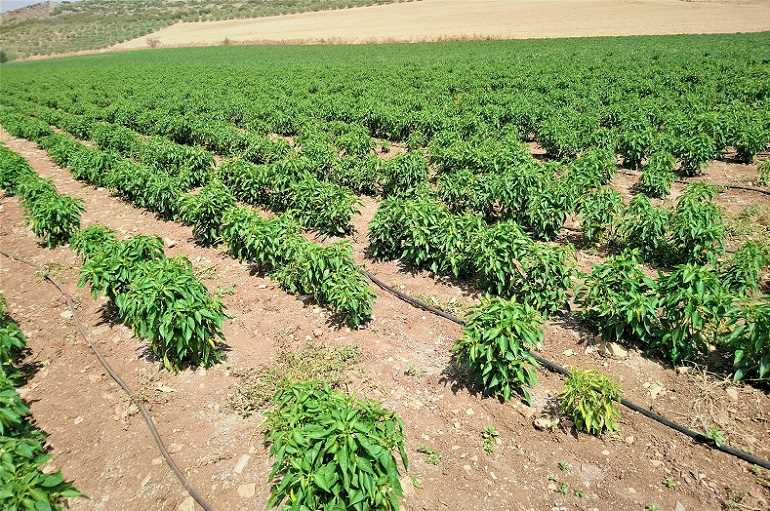
Pepper plants require specific conditions to thrive and produce an abundant harvest. By providing the right care, such as proper watering, adequate sunlight, and appropriate spacing, you can create an optimal environment for the plants to grow.
2. Disease Prevention:
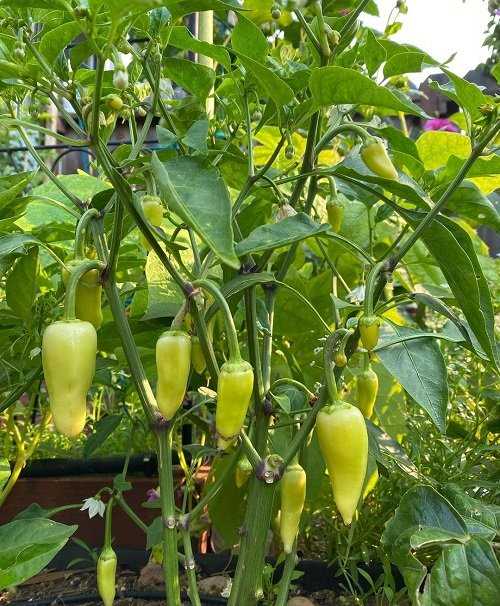
Adequate care helps in preventing common diseases that can affect pepper plants. Regularly inspecting the plants for any signs of pests, diseases, or nutrient deficiencies and taking necessary actions can help in preventing the spread of infections and keeping the plants healthy.
3. Nutrient Uptake:
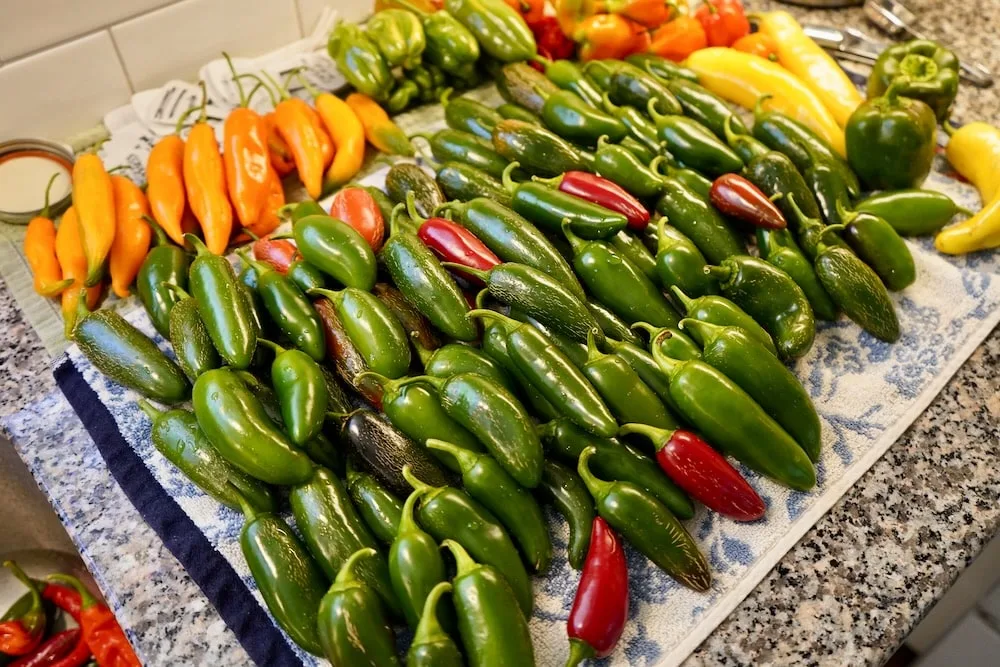
Proper care ensures that pepper plants receive the essential nutrients they need to grow and produce fruit. This includes providing a balanced fertilizer, ensuring proper soil pH, and regular monitoring of nutrient levels. With the right care, the plants can efficiently uptake and utilize these nutrients.
4. Increased Yield:
Good care practices such as pruning, staking, and proper spacing can help in maximizing the yield of pepper plants. By removing overcrowded branches, providing support to heavy fruit-laden branches, and ensuring sufficient airflow, you can promote the development of more fruits and increase overall yield.
5. Pest Control:
Proper care includes proactive pest control measures to minimize damage caused by insects or other pests. Regular scouting, using organic pest control methods, and maintaining overall plant health can help in preventing and managing pest infestations effectively.
Remember, providing proper care throughout the growing season is crucial for the success of your pepper plants. By implementing these care practices, you can promote healthy and productive bushes that will reward you with a bountiful harvest.
Choosing the Right Variety
Choosing the right variety of pepper plants is crucial for a successful harvest. There are numerous types of peppers available, each with its own unique characteristics and flavor profiles. Here are some factors to consider when selecting the right variety for your garden:
- Heat Level: Peppers come in various heat levels, ranging from mild to extremely hot. If you enjoy a little kick in your dishes, opt for varieties like jalapeno or serrano peppers. For a milder option, bell peppers are an excellent choice.
- Size and Shape: Peppers can vary in size and shape. Some are small and round, like cherry peppers, while others are elongated, such as banana peppers. Consider how you plan to use the peppers in your recipes and choose a variety that suits your needs.
- Color: Peppers come in a range of colors, including green, red, yellow, and orange. The color indicates the ripeness of the pepper, with green being the least ripe and red being the most. If you prefer sweeter peppers, wait until they turn red on the plant.
- Growing Conditions: Different pepper varieties have different requirements for sunlight, temperature, and soil conditions. Before choosing a variety, research its preferred growing conditions to ensure it will thrive in your garden.
It’s also a good idea to consider your personal taste preferences and what you plan to use the peppers for. Some varieties are better suited for fresh consumption, while others are ideal for pickling or adding heat to dishes. Take your time to explore the different options available and choose the right variety to enhance your pepper-growing experience.
Optimal Growing Conditions
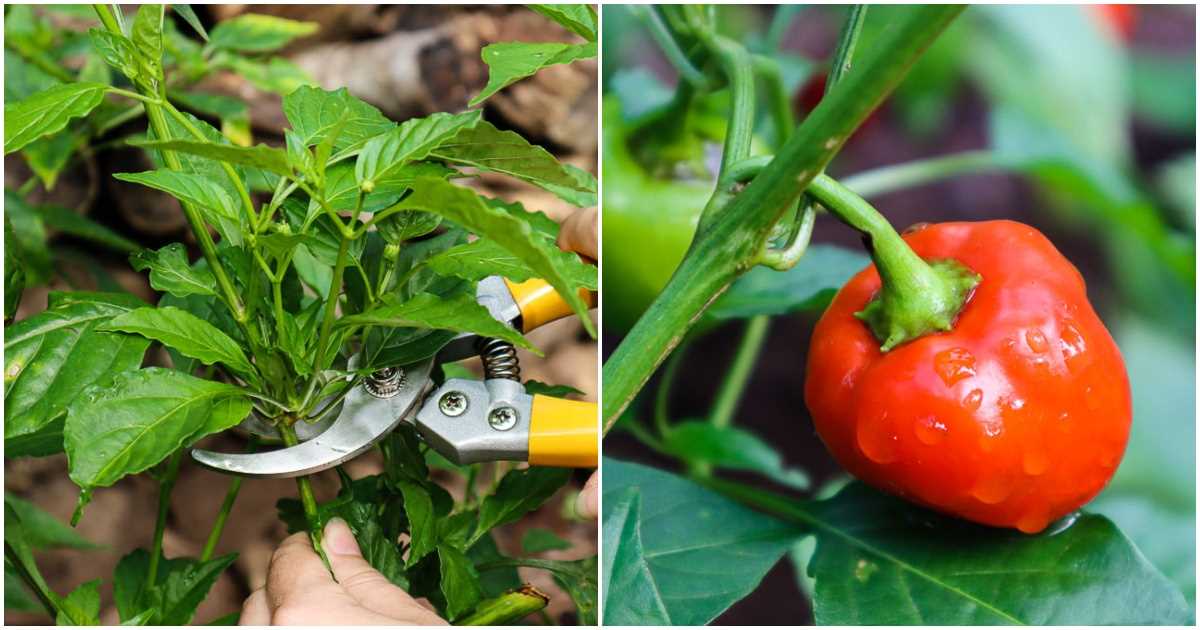
- Warm Climate: Peppers thrive in warm weather and require a growing season of at least 60-90 days with temperatures ranging from 70-85°F (21-29°C).
- Sunlight: Peppers need full sun exposure for at least 6-8 hours a day. Choose a location with ample sunlight or consider using artificial grow lights.
- Well-Drained Soil: Peppers prefer well-draining soil with a pH level between 6.0-7.0. Amend the soil with organic matter, such as compost, to improve drainage and fertility.
- Adequate Watering: Pepper plants require regular watering to keep the soil evenly moist. Avoid overwatering, as peppers are susceptible to root rot. It is recommended to water deeply once or twice a week, depending on the weather conditions.
- Frost-Free Environment: Peppers are sensitive to frost and should only be planted after the danger of frost has passed. Consider using protective covers, such as row covers or cloches, if frost is still a concern in your area.
- Spacing: Provide adequate spacing between pepper plants, usually around 18-24 inches (45-60 cm) apart. This allows for good air circulation and helps prevent the spread of diseases.
- Protection from Wind: Strong winds can damage pepper plants and inhibit growth. Plant peppers in a sheltered location or use windbreaks to protect them.
- Fertilization: Pepper plants benefit from regular fertilization. Use a balanced fertilizer or a specialized pepper fertilizer to provide the necessary nutrients for healthy growth.
- Pest and Disease Control: Monitor your plants regularly for pests like aphids, pepper maggots, and diseases like blossom end rot or bacterial spot. Use organic or chemical treatments as needed to prevent and control these issues.
By providing these optimal growing conditions, you can ensure that your pepper plants will thrive and produce a bountiful harvest of delicious peppers.
Providing Adequate Watering
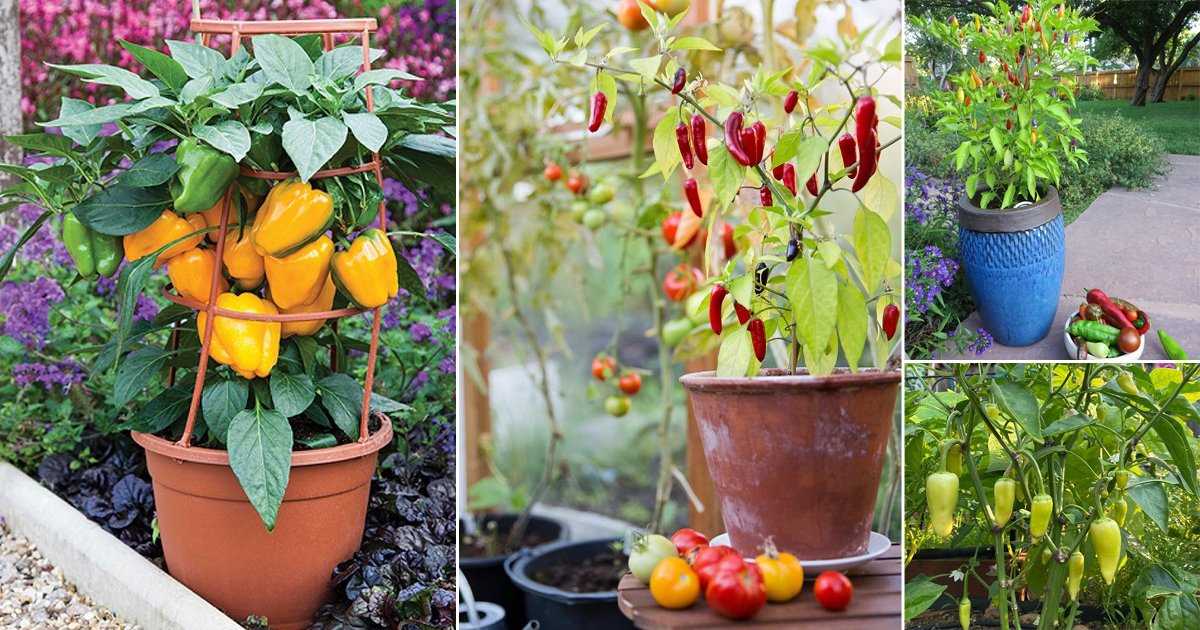
Watering is a crucial aspect of growing healthy pepper plants and ensuring a bountiful harvest. Proper watering techniques help maintain a consistent moisture level in the soil, which is essential for the plants’ growth and fruit development.
1. Watering Frequency
Pepper plants require regular and consistent watering to thrive. The frequency of watering depends on several factors, such as the climate, soil type, and stage of growth. In general, it’s important to keep the soil evenly moist but not waterlogged.
During the hot summer months, peppers may require watering every 2-3 days, especially if they are planted in containers or raised beds that tend to dry out quickly. In cooler seasons, reduce the frequency but always monitor the soil moisture levels to ensure the plants don’t become stressed.
2. Watering Techniques
There are a few effective watering techniques to provide adequate hydration to your pepper plants:
- Deep Root Watering: Instead of surface watering, which can lead to shallow root growth, aim to water the plants at the base, ensuring the water reaches the deeper roots. This encourages the roots to grow deeper and strengthens the plants.
- Drip Irrigation: Consider using a drip irrigation system to deliver water directly to the roots while minimizing water loss through evaporation. Drip irrigation also helps keep the foliage dry, reducing the risk of foliar diseases.
- Soaker Hoses: Another effective method is using soaker hoses, which release water slowly and directly into the soil, targeting the roots. Place the hoses around the base of the pepper plants, and allow them to run for a sufficient amount of time to ensure thorough watering.
3. Watering Amount
Pepper plants generally prefer consistent and deep watering rather than shallow and frequent watering. Ideally, provide enough water to moisten the top 6-8 inches of soil. However, avoid overwatering as it can lead to root rot and other diseases.
One way to check if your plants need water is to insert your finger into the soil up to the second knuckle. If the soil feels dry, it’s time to water. It’s important to note that the watering needs may vary depending on factors like weather conditions and the size of the plants.
4. Mulching
Applying a layer of organic mulch around the base of the pepper plants can help retain moisture in the soil, reduce evaporation, and prevent weed growth. Mulching also helps regulate soil temperature and improve overall soil structure.
Use materials like straw, wood chips, or dried leaves to create a mulch layer about 2-3 inches thick. Make sure to leave a small gap around the stem of the plants to prevent excess moisture accumulation and potential stem rot.
By following these watering tips and monitoring your plants’ moisture needs, you can provide the optimal conditions for your pepper plants, leading to vigorous growth and abundant yields.
Appropriate Fertilization Techniques
Proper fertilization is essential for promoting healthy growth and maximizing the yield of pepper plants. Here are some important techniques to consider when fertilizing your pepper plants:
1. Soil Testing
Before applying any fertilizers, it is recommended to perform a soil test to determine the nutrient levels and pH of your soil. This will help you understand the specific nutrient requirements of your pepper plants.
2. Balanced Fertilizer Selection
Pepper plants require a balanced mixture of macronutrients and micronutrients for optimal growth. Choose a fertilizer that has a balanced ratio of nitrogen (N), phosphorus (P), and potassium (K), as well as essential micronutrients such as iron, magnesium, and calcium.
3. Timing
Timing is key when it comes to fertilizing pepper plants. Apply fertilizers at the right time to ensure that the plants receive the nutrients they need at each growth stage. Start by incorporating a slow-release fertilizer into the soil before planting, then follow up with regular applications during the growing season.
4. Application Rates
It is important to apply fertilizers at the correct rates to prevent over or under fertilization. Follow the manufacturer’s instructions for the specific fertilizer you are using, and adjust the rates based on the needs of your pepper plants.
5. Placement
Proper placement of fertilizer is crucial for efficient nutrient uptake by the roots. Broadcast granular fertilizer evenly around the base of the pepper plants, avoiding direct contact with the stem. For liquid fertilizers, apply them directly to the soil around the plants.
6. Watering After Application
After fertilizing, make sure to water the plants thoroughly. This helps to dissolve and distribute the nutrients in the soil, making them available for the roots to absorb.
7. Organic Options
If you prefer organic gardening, there are various organic fertilizers available that provide the necessary nutrients for pepper plants. These include compost, manure, fish emulsion, and seaweed extracts.
8. Monitoring and Adjusting
Regularly monitor the growth and health of your pepper plants. If you notice any deficiencies or excesses in nutrient levels, adjust your fertilization techniques accordingly. This could involve increasing or decreasing the frequency or amount of fertilizer applied.
By following these appropriate fertilization techniques, you can provide your pepper plants with the essential nutrients they need for robust growth, increased yields, and healthier bushes.
Pest and Disease Management
Pepper plants are susceptible to a variety of pests and diseases. Here are some tips to help you manage them and keep your plants healthy:
Pest Management
1. Aphids: Apply insecticidal soap or a mixture of water and dish soap to control aphids. You can also introduce beneficial insects like ladybugs, lacewings, and parasitic wasps to help control aphid populations.
2. Spider Mites: Spider mites can be controlled by regularly spraying the leaves with water to wash off the mites. If the infestation is severe, consider applying a miticide or insecticidal soap.
3. Flea Beetles: Use row covers to prevent flea beetles from attacking your pepper plants. If you notice flea beetles, remove them by hand or spray the plants with neem oil or insecticidal soap.
4. Slugs and Snails: Create physical barriers like copper tapes or diatomaceous earth around your plants to prevent slugs and snails from reaching them. You can also handpick them in the evening when they are more active.
Disease Management
1. Bacterial Spot: Remove and destroy infected plants to prevent the spread of bacterial spot. Avoid overhead watering and provide good air circulation around the plants to reduce moisture on the leaves.
2. Powdery Mildew: Powdery mildew can be managed by applying sulfur-based fungicides or using neem oil. Make sure to water the plants at the base to keep the leaves dry.
3. Blossom End Rot: Blossom end rot is caused by calcium deficiency in the soil. Ensure a consistent and adequate supply of calcium through proper watering and adding calcium-rich fertilizers or amendments.
4. Phytophthora Root Rot: To manage phytophthora root rot, avoid overwatering and ensure proper drainage. Use disease-resistant pepper varieties and rotate crops to help prevent the disease.
By following these pest and disease management practices, you can minimize the impact of pests and diseases on your pepper plants and maximize their yield and health.
Pruning and Training Techniques
Pruning and training techniques play a crucial role in the growth and productivity of pepper plants. By implementing these techniques, you can ensure proper air circulation, sunlight exposure, and overall health of your pepper bushes. Here are some top tips to help you prune and train your pepper plants effectively:
1. Pinching off Suckers
One important technique is to pinch off suckers that grow between the main stem and the leaf branches. Suckers are secondary stems that can drain energy from the main plant, resulting in reduced fruit production. By removing them, you allow the plant to focus its energy on growing and ripening peppers.
2. Removing Diseased or Infected Leaves
Regularly inspect your pepper plants for any signs of disease or infection, such as yellowing leaves or spots. If you spot any diseased or infected leaves, promptly remove them to prevent the spread of the problem to other parts of the plant. This pruning technique helps maintain the overall health of the plant.
3. Supporting the Pepper Bushes
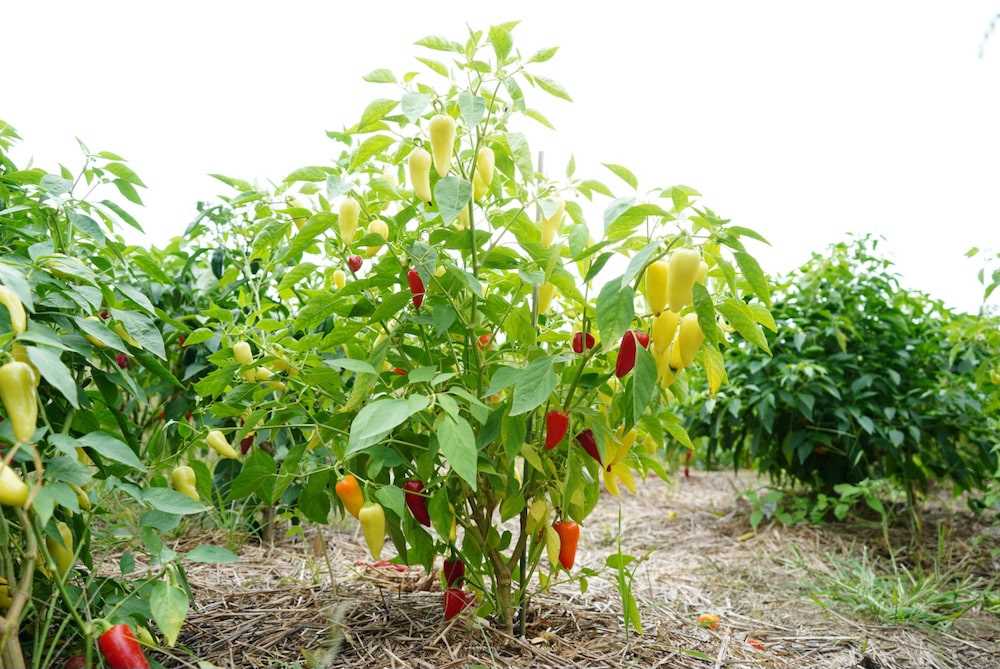
Pepper plants can become heavy with fruit, causing the branches to droop or even break. To prevent this, use stakes, tomato cages, or trellises to support the pepper bushes. Gently tie the branches to the support structure using soft gardening twine. This training technique ensures that the plants grow upright and the branches don’t snap under the weight of the peppers.
4. Pruning for Air Circulation
Adequate air circulation is vital for pepper plants as it helps prevent the development of fungal diseases. Prune the lower leaves and branches that touch the ground as they can become a breeding ground for fungal spores. Additionally, thin out dense foliage by removing some of the leaves and branches from the center of the plant to improve airflow.
5. Training the Main Stem
Training the main stem of pepper plants can help promote better growth and higher yields. When the plant is around 12 inches tall, gently pinch off the top leaves to encourage lateral growth. This technique stimulates the plant to produce more branches, leading to a bushier and more productive pepper plant.
6. Pruning Overgrown Plants
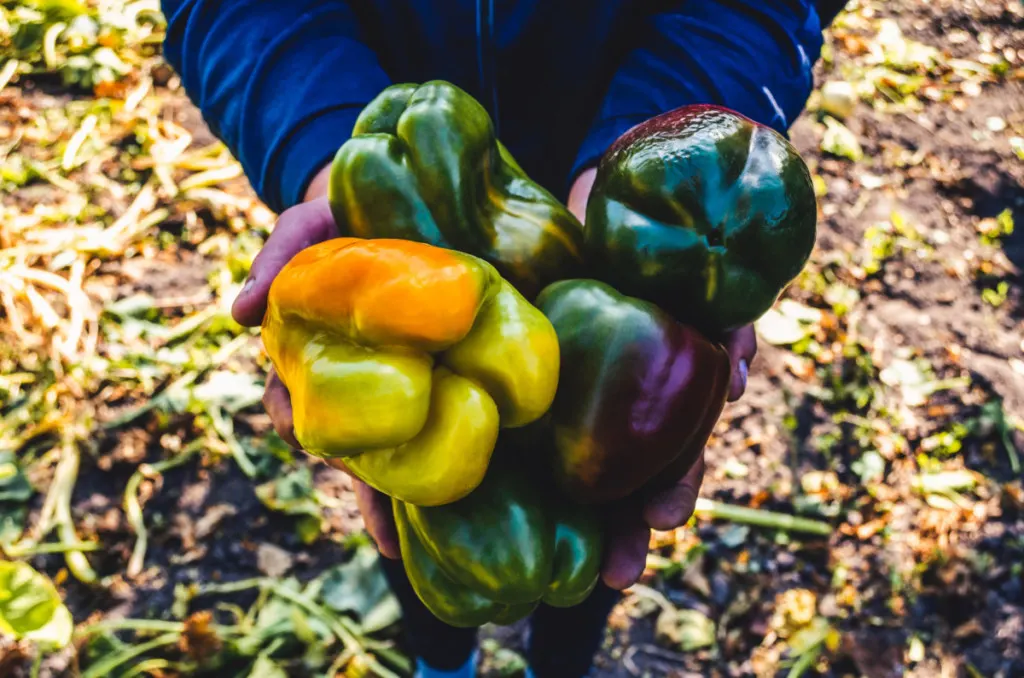
If your pepper plants become overgrown, prune them back to a manageable size. Remove any excessively long branches and trim the top to stimulate new growth. Pruning overgrown plants helps redirect energy to the remaining branches, resulting in better fruit production and overall plant health.
Remember to sterilize your pruning tools with rubbing alcohol or bleach between each cut to prevent the spread of disease. By implementing these pruning and training techniques, you can maximize the yield and strengthen the overall growth of your pepper bushes.
Harvesting and Storing Peppers
Harvesting peppers at the right time is essential to ensure optimal flavor and texture. Follow these tips for a successful pepper harvest:
- Wait until the peppers are fully mature before harvesting. They should have reached their full size and color.
- Use a sharp knife or pair of shears to cut the pepper from the plant. This helps prevent damage to the plant and ensures a clean cut.
- Avoid pulling the peppers off the plant as this can cause damage to the stem and plant.
- When harvesting, handle the peppers gently to avoid bruising or cutting the skin.
- Harvest peppers in the morning when they are cool and firm. This is when their flavor is at its peak.
- Check the peppers for any signs of disease or pest damage before harvesting. Discard any damaged peppers to avoid spreading the problem.
After harvesting, it’s important to store the peppers properly to maintain their freshness and quality. Here are some tips for storing peppers:
- Store peppers in a cool, dry place, such as the refrigerator. Peppers can stay fresh for up to two weeks when stored properly.
- Do not wash the peppers before storing, as this can promote rotting. Instead, wipe off any dirt or debris with a dry cloth.
- If you have an abundance of peppers, consider preserving them by freezing or canning. This can extend their shelf life for months.
- When freezing peppers, remove the stem, seeds, and inner membranes before placing them in a freezer-safe bag or container.
- For canning, follow a trusted recipe and process the jars according to the instructions to ensure safety.
By following these tips, you can enjoy a bountiful harvest of delicious peppers and make them last throughout the year.
“Question-Answer”
What are some tips for growing peppers?
Some tips for growing peppers include choosing the right location with plenty of sunlight, using rich and well-drained soil, providing regular and consistent watering, and applying organic fertilizer.
How can I boost the yield of my pepper plants?
To boost the yield of your pepper plants, you can start by pinching off the first buds that appear on the plants. This will encourage more branches and more fruit to grow. Additionally, providing adequate water and nutrients, such as organic fertilizer, can also help increase yield.
What type of soil is best for growing peppers?
The best type of soil for growing peppers is rich and well-drained soil. Peppers prefer a pH level between 6.0 and 6.8. Adding organic matter, such as compost, to the soil can help improve its fertility and drainage.
How often should I water my pepper plants?
It is important to provide regular and consistent watering to your pepper plants. They usually require about 1-2 inches of water per week, depending on the weather conditions. It’s best to water deeply and less frequently rather than shallowly and frequently.
Can you give some advice on protecting pepper plants from pests?
To protect pepper plants from pests, you can start by regularly inspecting the plants and removing any pests you find by hand. Applying natural pest repellents, such as neem oil or garlic spray, can also help deter pests. Additionally, planting companion plants like marigolds or basil can attract beneficial insects that prey on pests.
What are the benefits of using organic fertilizer for pepper plants?
Using organic fertilizer for pepper plants offers several benefits. It provides essential nutrients to the plants, improves the soil structure, promotes microbial activity, and enhances long-term soil fertility. Organic fertilizers also tend to be more environmentally friendly and sustainable compared to synthetic fertilizers.







